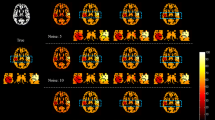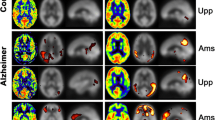Abstract
Arterial spin labeling is a recently emerging imaging modality in functional magnetic resonance, and it is widely acknowledged to be effective in directly measuring the cerebral blood flow of patients while being scanned, which makes it a promising indicator in contemporary dementia disease diagnosis studies. However, partial volume effects mainly caused by signal cross-contamination due to pixel heterogeneity and limited spatial resolution of the arterial spin labeling scanning protocol often prevent the cerebral blood flow from being accurately measured. In order to correct the partial volume effects, contemporary studies usually rely on neighboring pixles to solve indefinite equations of partial volume correction, which makes shortcomings of blurring and brain tissue details loss inevitable in their correction outcomes. In this study, a novel pixel-wise correction method is proposed to tackle partial volume effects in arterial spin labeling images. The main idea is to formalize the correction problem as a series of quadratic programming sub-problems using split-Bregman iterations, then formulate each sub-problem via the regularization of least absolute shrinkage and selection operator, and finally solve the regularization sub-problem via the fast proximal gradient descent approach. A real-patients database composed of 360 demented patients is incorporated for experimental evaluation of the pixel-wise method. Extensive experiments and comprehensive statistical analysis are carried out to demonstrate the superiority of the pixel-wise method with comparisons towards the popular region-based method. Promising results are reported from the statistical point of view.





Similar content being viewed by others
References
Abad V, Garcia-Polo P, O’Daly O, Hernandez-Tamames J, Zelaya F (2016) ASAP (automatic software for ASL processing): A toolbox for processing arterial spin labeling images. Magn Reson Imaging 34:334–344
Asllani I, Borogovac A, Brown T (2008) Regression algorithm correcting for partial volume effects in arterial spin labeling MRI. Magn Reson Med 60:1362–1371
Boyd S, Vandenberghe L (2004) Convex optimization. Cambridge University Press, Cambridge, UK
Brant-Zawadzki M, Gillan G, Nitz W (1992) MPRAGE: A three-dimensional, T1-weighted, Qradient-echo sequence–initial experience in the brain. Radiology 182 (3):769–775
Brookmeyer R, Johnson E, Ziegler-Graham K, Arrighi M (2007) Forecasting the global burden of alzheimer’s disease. Alzheimers Dement 3(3):186–191
Bruening D, Dharssi S, Lazar R, Marshall R, Asllani I (2015) Improved partial volume correction method for detecting brain activation in disease using arterial spin labeling (ASL) fMRI, International Conference of the IEEE Engineering in Medicine and Biology Society
Chapell M (2011) Partial volume correction of multiple inversion time arterial spin labeling MRI data. Magn Reson Med 65:1173–1183
Chen Y, Wolk D, Reddin J, Korczykowski M, Martinez P, Musiek E, Newberg A, Julin P, Arnold S, Greenberg J, Detre J (2011) Voxel-level comparison of arterial spin-labeling perfusion MRI and FDG-PET in alzheimer disease. Neurology 77(2):1977–1985
Davatzikos C, Fan Y, Wu X, Shen D, Resnick S (2008) Detection of Prodromal Alzheimer’s Disease via Pattern Classification of Magnetic Resonance Imaging. Neurobiol Aging 29:514–523
Erlandsson K, Buvat I, Pretorius H, Thomas B, Hutton B (2012) A review of partial volume correction techniques for emission tomography and their applications in neurology, cardiology and oncology. Phys Med Biol 57:119–159
FMRIB Software Library (FSL) toolbox, http://fsl.fmrib.ox.ac.uk/fsl/fslwiki/
Galton C, Patterson K, Graham K, Lambon-Ralph M, Williams G, Antoun N, Sahakian B, Hodges J (2001) Differing patterns of temporal atrophy in alzheimer’s disease and semantic dementia. Neurology 57(2):216–225
Gold G, Eniko K, Herrmann F, Canuto A, Hof P, Jean-Pierre M, Constantin B, Giannakopoulos P (2005) Cognitive consequences of thalamic, basal ganglia, and deep white matter lacunes in brain aging and dementia. Stroke 36 (6):1184–1188
Goldstein T, Osher S (2008) The split bregman method for l1 regularized problems, UCLA CAM report, no. 08-29, pp 1–21
Iaccarino H, Singer A, Martorell A, Rudenko A, Gao F, Gillingham T, Mathys H, Seo J, Kritskly O, Abdurrob F, Adaikkan C, Canter R, Rueda R, Brown E, Boyden E, Tsai L (2016) Gamma Frequency Entrainment Attenuates Amyloid Load and Modifies Microglia. Nature 540:230–235
Joachims T (2002) Optimizing Search Engines using Clickthrough Data. ACM Special Interest Group on Knowledge Discovery and Data Mining, pp 133–142
Liu M, Zhang D, Shen D (2012) Ensemble sparse classification of alzheimer’s disease. NeuroImage 60(2):1106–1116
Meltzer C, Leal J, Mayberg H, Wagner H, Frost J (1990) Correction of PET data for partial volume effects in human cerebral cortex by MR imaging. J Comput Assist Tomogr 14(4):561–70
Musiek E, Chen Y, Korczykowski M, Saboury B, Martinez P, Reddin J, Alavi A, Kimberg D, Wolk D, Julin P, Newberg A, Arnold S, Detre J (2012) Direct comparison of fluorodeoxyglucose positron emission tomography and arterial spin labeling magnetic resonance imaging in alzheimer’s disease. Alzheimers Dement 8(1):51–59
Oliver R (2015) Improved quantification of arterial spin labelling images using partial volume correction techniques, Doctoral thesis, University College London
Statistical Parametric Mapping (SPM) toolbox, http://www.fil.ion.ucl.ac.uk/spm/
Tibshirani R (1996) Regression shrinkage and selection via the LASSO. J Royal Stat Soc - Ser B 58(1):267–288
Tikhonov A, Arsenin V (1977) Solution of Ill-posed problems. Bullet Amer Math Soc 1(3):521–524
United Nations, World Population Prospects, http://www.un.org/esa/population/publications/wpp2006/WPP2006_Highlights_rev.pdf
Wee C, Yap P, Shen D (2013) Prediction of alzheimer’s disease and mild cognitive impairment using cortical morphological patterns. Human Brain Mapp 34 (12):3411–3425
World Health Organization, The Top 10 Causes of Death, http://www.who.int/mediacentre/factsheets/fs310/en/index2.html
Zhou L, Wang Y, Li Y, Yap P, Shen D (2011) Hierarchical anatomical brain networks for mci prediction: Revisiting volumetric measures. PLoS Comput Biol 6(7):e21935
Zou H, Hastie T (2005) Regularization and variable selection via the elastic net. J Royal Stat Soc - Ser B 67(1):301–320
Acknowledgments
The authors would like to acknowledge Grants 61403182, 61363046 and 61571362 approved by the National Natural Science Foundation of China, the Grant [2014]1685 approved by the Scientific Research Foundation for Returned Overseas Chinese Scholars, Ministry of Education, China, the 2015 Provincial Young Scientist Program 20153BCB23029 approved by the Jiangxi Provincial Department of Science and Technology, China, as well as the Grant JXJG-15-1-26 approved by the Jiangxi Provincial Department of Education for supporting this study.
Author information
Authors and Affiliations
Corresponding author
Rights and permissions
About this article
Cite this article
Huang, W., Wan, C., Zeng, J. et al. Pixel-wise partial volume effects correction on arterial spin labeling magnetic resonance images. Multimed Tools Appl 77, 6913–6932 (2018). https://doi.org/10.1007/s11042-017-4609-x
Received:
Revised:
Accepted:
Published:
Issue Date:
DOI: https://doi.org/10.1007/s11042-017-4609-x




